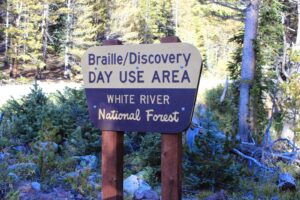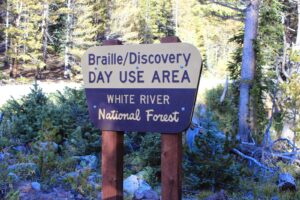
When I consider how my life is spent
Ere half my days in this dark world and wide,
—John Milton, “On his Blindness”
Sometimes discovery comes in unexpected ways. In the White River National Forest of Colorado, at an elevation of more than 10,200 feet above sea level, the
Braille/Discovery Trail welcomes all visitors, especially those who cannot see and those who cannot walk.
Just off highway 82 below the grandeur and hair-raising curves of Independence Pass and 12.5 miles east of Aspen, this pristine gem borders the Roaring Fork River under a cathedral of towering rock, spruce, fir, and coniferous pine.
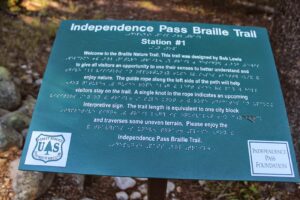
Two short quarter-mile trails depart from the parking area. The wheelchair accessible Discovery Trail has dedicated picnic spots along the path. The Braille Trail threads a hands-on knotted rope connecting interpretive educational signs both in braille and script alphabet. Both methods of lettering describe the flora and fauna of the natural environment.

Here the river offers the music of snowmelt tumbling from the peaks. The breeze wafts fragrant scents. Bark patterns on trees reveal time and species to human fingertips. The ground stretches ahead spongy in places, soggy in others, hard-packed or rocky farther on. Listen, while the Hermit Thrush sings a clear-noted symphony in the forest halls.
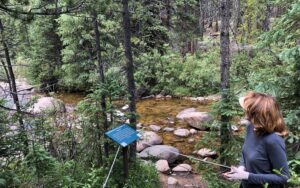
Founded in 1967, the Braille Trail was the first of its kind in the entire world. The Discovery Trail was added in the late 1990s. What wonderful sensory accessibility Robert B. Lewis conceived of when he dreamed up this special place and named it after Louis Braille who encouraged the blind to see through their fingertips.
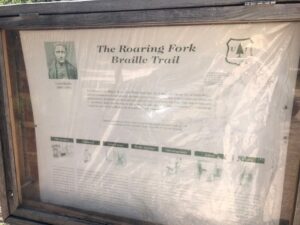
I wonder if Lewis also knew this trail would encourage sighted individuals who had lost their ability to see beauty in the natural world, the opportunity to simply see again. I love stopping here and honor the accessible paths that touch so many lives.
Thanks for stopping by. ♥
Thanks to gjhikes.com for use of some of the above photos.

